
On
The Relationship between Elliott and Montgomery
This article is based on two letters from Elliott to Montgomery and examines the change in relationship between the two Sheffield poets over the years between the letters. Elliott’s letters were sent in 1823 and 1833.
James Montgomery (1771-1854) was a contemporary of Elliott. A wealthy man, he was a newspaper owner, a prolific poet and a writer of four hundred hymns, the most famous being “Angels From The Realms Of Glory.”
When he was twenty-two, Montgomery
started work on “The Sheffield Register” newspaper which he owned from 1794,
re-titling it the “Sheffield Iris,” a paper he ran for 31 years. In the next
two years, his radical newspaper columns irritated the authorities and he was
twice sent to prison. In later years, he moderated his views and became an influential
figure in the cultural life of the city. He never married. At his funeral,
shops and factories closed as a mark of respect and the funeral procession took
an hour to pass. A statue of him was erected, streets were named after him and
there is a Montgomery Hall in the city centre. Elliott, too, was to be
commemorated with a statue.
The
1823 Letter To James Montgomery
Dated 7th
March 1823, the letter respectfully requested Montgomery to accept a copy of
Elliott’s new book and if he had any influence with the critics “do use it for
my benefit.” The new book was called ”Love’ which was printed in 1822 but not
published until 1823, the date of this letter. “Love” Elliott said “may be
called a sort of child of your own.” This mysterious observation could relate
to the Sheffield Iris newspaper being willing to include poems from the young
poet. Another perplexing remark then referred to a trouble which Elliott had
caused for Montgomery. The Rhymer regrettably did not enlarge on this spat. A picture of Montgomery is shown below.
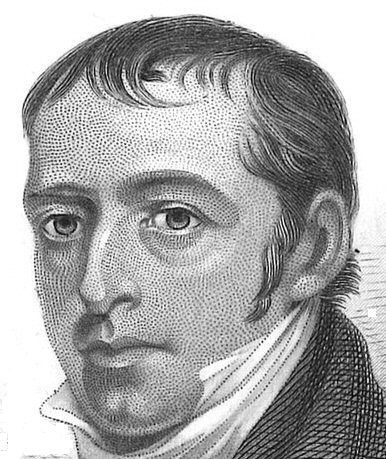 The full
title for Elliott’s new book was “Love: A Poem In Three Parts; To Which Is
Added The Giaour, A Satirical Poem.” Elliott volunteered that Montgomery would
not like this new poem. He was correct. Elliott’s poem,” The Giaour,” is a
lampoon of Byron who had written a highly successful poem called “The Giaour”
in 1813. In the same year, the young Elliott had tried to introduce himself to
the great lord outside a bank in Rotherham and was very annoyed to be treated
with scorn. Ten years later Elliott was still sore about the incident and wrote
his own poem called “The Giaour” where he ridiculed the famous lord.
The full
title for Elliott’s new book was “Love: A Poem In Three Parts; To Which Is
Added The Giaour, A Satirical Poem.” Elliott volunteered that Montgomery would
not like this new poem. He was correct. Elliott’s poem,” The Giaour,” is a
lampoon of Byron who had written a highly successful poem called “The Giaour”
in 1813. In the same year, the young Elliott had tried to introduce himself to
the great lord outside a bank in Rotherham and was very annoyed to be treated
with scorn. Ten years later Elliott was still sore about the incident and wrote
his own poem called “The Giaour” where he ridiculed the famous lord.
The end of Elliott’s letter is amusing – something only rarely seen in the work of the Corn Law Rhymer. He had decided to deliver the manuscript of “Love” to Montgomery personally, but on reaching Miss Gales’s door, Elliott’s courage failed and he tellingly expressed himself as follows: “when my iron nerves enabled me to heroically carry it back again, without troubling you.” This revealed a total lack of self-confidence in meeting his social superior. It also displayed a rare humorous touch of self-mockery.
Miss Gales, who was mentioned in the letter, lived with her two sisters under Montgomery’s wing. Their father, who had founded the radical Sheffield Register newspaper, had to flee abroad to avoid arrest leaving his daughters helpless until Montgomery took responsibility for the three of them.

Elliott’s letter finished with “I am, DSir, Yours very truly, E. Elliott.” Note here that this was a formal signature – the normal signature would have been “Ebenezer Elliott.” The phrase “Yours Truly” was also a more formal signing off. The whole letter was very brief and respectful. Elliott in 1823 was a minor, unknown poet though he was being published: in 1801 came “The Vernal Walk;” in 1818 “Night” appeared and “Peter Faultless” followed in 1820. There was a social gulf between the two men which explained Elliott’s timid approach. Montgomery was a successful businessman and a well-known poet: Elliott was a struggling tradesman, yet to make his mark.
Six
months after the 1823 letter, the famous poet, Robert Southey, visited
Sheffield and had a meeting with Elliott on November 7th 1823. Significantly,
James Montgomery was also present at the meeting. The meeting was a turning point
in Elliott’s relationship with Montgomery since Southey’s interest in the
upcoming poet greatly impressed Montgomery. From Southey’s letters, we know
that he was clearly impressed by the young Elliot.
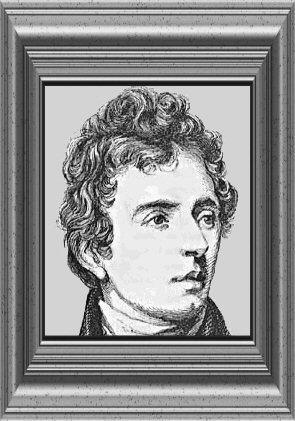
ROBERT SOUTHEY
With the publication of his “Corn Law Rhymes” in 1831, Elliott was quickly established as a poet of stature. This further altered his relationship with Montgomery. A letter of 1832 revealed that Elliott submitted his manuscript of “The Splendid Village” to Montgomery and was pleased with the latter’s suggestions. This showed that the two poets were now on a friendlier standing. “The Splendid Village” was published in 1833.
Another indication of the growing relationship was demonstrated when Elliott dedicated his epic poem “Spirits And Man” to Montgomery saying “I dedicate to James Montgomery, author of ’The World Before The Flood,’ in this fragment an evidence of my presumption and my despair.” Another puzzling remark. No date has been found for Elliott’s “Spirits And Man” but in his preface he was critical of Montgomery’s “The World Before The Flood.” Both the dedication and the criticism demonstrated Elliott’s self-confidence and, indeed, his fearlessness.
The 1833 Letter To James Montgomery
This was a much longer letter showing Elliott confidence was now high. The tone was much different too - Elliott addressing Montgomery as an equal. He now signed his name as “Ebenezer Elliott” and signed off with “I am, DSir, Your much oblig’d friend.” Note the word “friend.”
The letter
began with another mystery: “If I had intentionally inflicted upon you the
torture which you have endured from me, I should indeed be a monster.” One
wonders to what this referred. It does, however, indicate increasing
familiarity between the two poets. Elliott next referred to a letter from
Montgomery that let Elliott into a secret. This again suggested the two were
close, though the secret was not explained. This was followed by a hint that
Montgomery had made an apology to Elliott: “You never neglected me, on the
contrary, you did more to bring my early writings into notice than all the
world beside.”
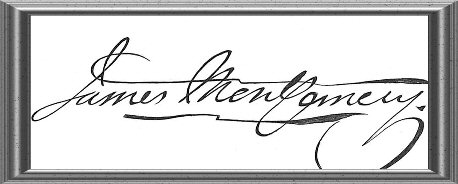
MONTGOMERY’S FLAMBOYANT SIGNATURE
The next lines of the letter had a sense that Elliott might have offended
Montgomery’s friends with remarks about religion. Elliott concluded that religious
people “seem to me to have telescopic eyes.” Meaning that they home in on the
smallest thing and make an issue of it.
The following
section of the letter is most interesting since it showed that Elliott’s self-confidence
allowed him to give advice to Montgomery. In Elliott’s eyes they were equal.
“Will you allow me to say, that you, perhaps, lock yourself up too much in your
study?” He then recommended his friend (we can use that word now) to do some
gardening, get out in the countryside and climb a few mountains. The Rhymer
explained his reasoning: three years ago his sight had deteriorated rapidly.
“Never before was I so humiliated as when forced to wear spectacles.” A trip
into Derbyshire had wrought a great improvement in his health and in his sight.
The benefit of the countryside was “Win-Hill” which was “a poem, the best I
have yet written.” A strong recommendation to Montgomery to take a holiday in
the Peak District. (Click here for a study of the Win-Hill poem).
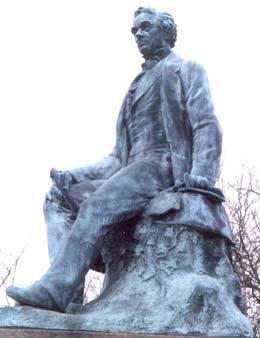
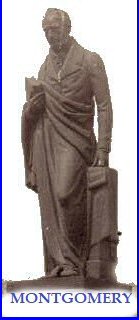
THE TWO STATUES
ELLIOTT LEFT, MONTGOMERY RIGHT
Clearly the relationship between Elliott and Montgomery had changed somewhat, though Jingling James – as a newspaper affectionately christened Montgomery – stated that they did not meet often and that their meetings were short. However, this statement should be treated with caution since throughout the 1830s and 1840s, the two of them attended meetings at the Sheffield Mechanics’ Institute where Montgomery was chair and Elliott was vice-chair. In Montgomery’s day, social distinctions were more rigid than they are today, and it is likely that with the gulf in their social status they had little or no contact in social settings. They were acquaintances rather than bosom friends.
After the
“Corn Law Rhymes” were published, Elliott became nationally famous, and all the
world came to his door. The American lawyer, Henry B. Stanton, visited
Sheffield in 1840 and declared “Of the two Sheffield poets, Elliott’s grasp of
intellect was much the stronger, his genius far more buoyant and elastic.”
[Note that the two letters mentioned in this article are to be found in the Morgan Library and Museum in the USA].
To return to Ebenezer's home page, please click here
Or to leap to Ebenezer's poetry pages, use this
To return to the Ebenezer Research Foundry, please bash the anvil 